- Accueil
- Pages cachées
- 19 NOVEMBRE 2023 NEWS
19 NOVEMBRE 2023 NEWS
INSTITUT SUPERIEUR D'ANTHROPOLOGIE
INSTITUT OF ANTHROPOLOGY
COURS ONLINE – COURS A DISTANCE
INSCRIPTIONS OUVERTES
REGISTER NOW
TURQUIE – 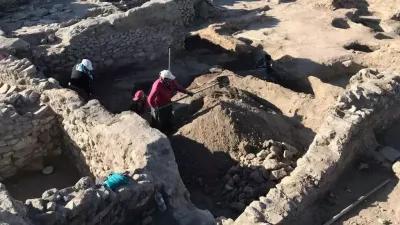 Kültepe - A 4,300-year-old braided mat has been found in the Kültepe Kaniş Karum Ruins, which dates back 6,000 years in Central Anatolia . The head of the excavations, Ankara University Department of Archeology Professor Fikri Kulakoğlu said, “This year, a mat was found in situ, that is, in its original place. Of course, wicker is an element made of reeds and it is not possible for it to survive for such a long period of time. Anyway, we are now trying to remove traces of it, almost like dust. If we can remove it, we plan to exhibit it at a museum. It will be the first of its kind.” "The excavations continue mainly on the hill as well as in the area we call 'Lower City' or 'Karum.' From now on, we will continue as long as the weather allows. But we can continue for one more month at most," Kulakoğlu said. Stating that they found important artifacts this year, Kulakoğlu said, "We worked in many different sectors and fields in this year's work. Our latest excavation area is an area of large monumental buildings from 4,250-4,300 years ago. We have been here since 2017. We are trying to finish the excavation of the building. Last year, in the place where we are currently excavating, we opened an idol room, the plan of which is now becoming clear, and a structure that should have been a sacred room, containing more than 100 idols and figurines.” Kulakoğlu said that they are searching the continuation of the structure, and added, “Similar to what we found last year, we find idols and figurines in the next room. In addition, the imported materials, which we call 'Kernos,' similar to the round bagel-shaped containers, are found, too. This year, we found a mat. If we can remove it, we plan to exhibit it in a museum as a beautiful example. These are not a new find; there are similar examples in Kültepe or other places. But this is the first time we see an example with such a beautiful texture and clear weaving pattern. This mat even has a tassel. Let's see what we will find in other parts of the room.” Kulakoğlu emphasized the importance of wicker as a beautiful example in the aesthetic sense, saying, “In fact, such organic materials cannot always survive that long. But in this example, traces are a little thicker and a little deeper. These are ash materials that almost disappear as soon as you touch them. But our team found it well while digging. It was possible to see its texture, its tassel, and its very fine fibers. Its thickness is currently 2-3 millimeters. But it is important in terms of weaving.”
Kültepe - A 4,300-year-old braided mat has been found in the Kültepe Kaniş Karum Ruins, which dates back 6,000 years in Central Anatolia . The head of the excavations, Ankara University Department of Archeology Professor Fikri Kulakoğlu said, “This year, a mat was found in situ, that is, in its original place. Of course, wicker is an element made of reeds and it is not possible for it to survive for such a long period of time. Anyway, we are now trying to remove traces of it, almost like dust. If we can remove it, we plan to exhibit it at a museum. It will be the first of its kind.” "The excavations continue mainly on the hill as well as in the area we call 'Lower City' or 'Karum.' From now on, we will continue as long as the weather allows. But we can continue for one more month at most," Kulakoğlu said. Stating that they found important artifacts this year, Kulakoğlu said, "We worked in many different sectors and fields in this year's work. Our latest excavation area is an area of large monumental buildings from 4,250-4,300 years ago. We have been here since 2017. We are trying to finish the excavation of the building. Last year, in the place where we are currently excavating, we opened an idol room, the plan of which is now becoming clear, and a structure that should have been a sacred room, containing more than 100 idols and figurines.” Kulakoğlu said that they are searching the continuation of the structure, and added, “Similar to what we found last year, we find idols and figurines in the next room. In addition, the imported materials, which we call 'Kernos,' similar to the round bagel-shaped containers, are found, too. This year, we found a mat. If we can remove it, we plan to exhibit it in a museum as a beautiful example. These are not a new find; there are similar examples in Kültepe or other places. But this is the first time we see an example with such a beautiful texture and clear weaving pattern. This mat even has a tassel. Let's see what we will find in other parts of the room.” Kulakoğlu emphasized the importance of wicker as a beautiful example in the aesthetic sense, saying, “In fact, such organic materials cannot always survive that long. But in this example, traces are a little thicker and a little deeper. These are ash materials that almost disappear as soon as you touch them. But our team found it well while digging. It was possible to see its texture, its tassel, and its very fine fibers. Its thickness is currently 2-3 millimeters. But it is important in terms of weaving.”
A 4,300-year-old mat found in Kültepe (hurriyetdailynews.com)
TURQUIE –
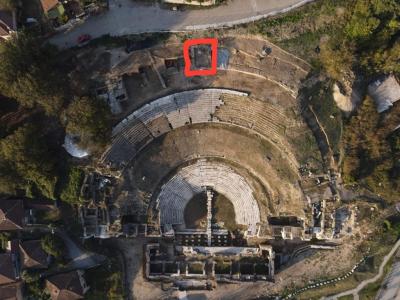
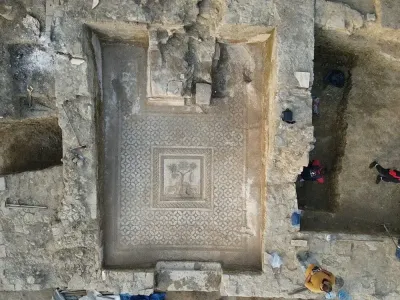 Prusias ad Hypium - Following the recent Alexander the Great statue that was found in September in the ancient city of Prusias ad Hypium in the Konuralp district of Düzce, where excavations have been ongoing for four years, a lion mosaic was unearthed in a room discovered during the excavations. The mosaic structure was unearthed in the middle of the theater axis, according to a statement made by the museum. “It was determined that the interior walls of this room structure were covered with marble plates on a thick layer of mortar and that the room had a rectangular plan in the north-south direction. A platform foundation is observed towards the north of the room, towards the interior. It was observed that the entire room was covered with a mosaic floor consisting of white, blue, yellow, green and brown tesserae made with fine workmanship. The edges of the mosaic, decorated with geometric patterns, are made in the form of a frame consisting of larger and colorful tesserae. Artifacts show us that this place was the Dionysus Cult Place,” the statement said. Düzce Mayor Faruk Özlü stated that they encountered a new artifact every day during the excavations in Konuralp, adding, “We discovered a unique mosaic in Türkiye. This mosaic is an important element of the Ancient Theater here that has not come to light. We had previously found a statue of Medusa, a statue of Apollo and a statue of Alexander the Great here. This is the fourth important artifact we found, a work called the Lion Mosaic. Archaeologists state that it is a unique artifact.”
Prusias ad Hypium - Following the recent Alexander the Great statue that was found in September in the ancient city of Prusias ad Hypium in the Konuralp district of Düzce, where excavations have been ongoing for four years, a lion mosaic was unearthed in a room discovered during the excavations. The mosaic structure was unearthed in the middle of the theater axis, according to a statement made by the museum. “It was determined that the interior walls of this room structure were covered with marble plates on a thick layer of mortar and that the room had a rectangular plan in the north-south direction. A platform foundation is observed towards the north of the room, towards the interior. It was observed that the entire room was covered with a mosaic floor consisting of white, blue, yellow, green and brown tesserae made with fine workmanship. The edges of the mosaic, decorated with geometric patterns, are made in the form of a frame consisting of larger and colorful tesserae. Artifacts show us that this place was the Dionysus Cult Place,” the statement said. Düzce Mayor Faruk Özlü stated that they encountered a new artifact every day during the excavations in Konuralp, adding, “We discovered a unique mosaic in Türkiye. This mosaic is an important element of the Ancient Theater here that has not come to light. We had previously found a statue of Medusa, a statue of Apollo and a statue of Alexander the Great here. This is the fourth important artifact we found, a work called the Lion Mosaic. Archaeologists state that it is a unique artifact.”
Lion mosaic latest find in Konuralp ancient city (hurriyetdailynews.com)
SERBIE – 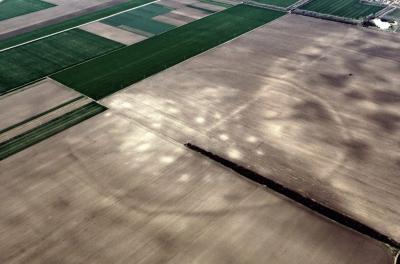 - Using Google Earth and aircraft reconnaissance, archaeologists at University College Dublin identified more than 100 previously unknown sites. During the Bronze Age, people across Eurasia formed massive trade networks that linked the continent together. However, the Pannonian Plain, an open expanse that now includes parts of Romania, Hungary, and Serbia, was thought to be a distant hinterland. That was true even after archaeologists discovered a handful of massive Bronze Age enclosures, some protected by kilometers-long walls and ditches, two decades ago. Although sporadic discoveries of bronze artifacts suggested the enclosures weren’t entirely isolated, no one was certain how the structures related to cultural advancements occurring elsewhere in Europe. Molloy and other archaeologists turned to satellite imagery to see whether they could spot more structures that ground-based investigations had missed.Last week, in PLOS ONE, they reported finding more than 100 of these distinct enclosures in what is today Serbia. They form a 150-kilometer-long belt along the Tisza River, a major north-south artery that divides the Pannonian Plain. The findings indicate that the structures were part of a vast network of settlements that participated in a thriving, continent-wide bronze trade that flourished around 3600 years ago. The structures, many identified for the first time, have been hiding in plain sight. Many are invisible from the ground because they were plowed nearly flat after decades of intensive agriculture or destroyed in prehistoric times. After identifying the enclosures in Google Earth photos, Molloy and his team flew over the area in a small airplane, then visited as many of the sites as possible by foot. “We spent a lot of time trudging through mud,” Molloy says. They found pottery fragments, stones for grinding grain, and animal bones littering the surface—ancient artifacts churned up by decades of intensive plowing. Test pits revealed even more such artifacts. Comparing pottery to known sites in the region, the researchers estimated the enclosures dated to between 1550 B.C.E. and 1200 B.C.E. Radiocarbon dates from the animal bones confirmed that range. The sheer size of the enclosures means they may remain enigmatic for years to come. But researchers helping fill in a blank spot on the map of Bronze Age Europe.
- Using Google Earth and aircraft reconnaissance, archaeologists at University College Dublin identified more than 100 previously unknown sites. During the Bronze Age, people across Eurasia formed massive trade networks that linked the continent together. However, the Pannonian Plain, an open expanse that now includes parts of Romania, Hungary, and Serbia, was thought to be a distant hinterland. That was true even after archaeologists discovered a handful of massive Bronze Age enclosures, some protected by kilometers-long walls and ditches, two decades ago. Although sporadic discoveries of bronze artifacts suggested the enclosures weren’t entirely isolated, no one was certain how the structures related to cultural advancements occurring elsewhere in Europe. Molloy and other archaeologists turned to satellite imagery to see whether they could spot more structures that ground-based investigations had missed.Last week, in PLOS ONE, they reported finding more than 100 of these distinct enclosures in what is today Serbia. They form a 150-kilometer-long belt along the Tisza River, a major north-south artery that divides the Pannonian Plain. The findings indicate that the structures were part of a vast network of settlements that participated in a thriving, continent-wide bronze trade that flourished around 3600 years ago. The structures, many identified for the first time, have been hiding in plain sight. Many are invisible from the ground because they were plowed nearly flat after decades of intensive agriculture or destroyed in prehistoric times. After identifying the enclosures in Google Earth photos, Molloy and his team flew over the area in a small airplane, then visited as many of the sites as possible by foot. “We spent a lot of time trudging through mud,” Molloy says. They found pottery fragments, stones for grinding grain, and animal bones littering the surface—ancient artifacts churned up by decades of intensive plowing. Test pits revealed even more such artifacts. Comparing pottery to known sites in the region, the researchers estimated the enclosures dated to between 1550 B.C.E. and 1200 B.C.E. Radiocarbon dates from the animal bones confirmed that range. The sheer size of the enclosures means they may remain enigmatic for years to come. But researchers helping fill in a blank spot on the map of Bronze Age Europe.
PAKISTAN – 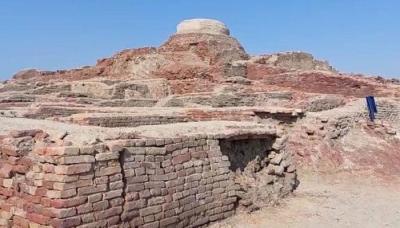 Mohenjo Daro - In a major discovery, a team of experts discovered a pot full of copper coins from archaeological site, Mohenjo Daro, during conservation work, The News reported Friday. Sources revealed that a group of labourers were excavating a collapsed wall when they came across a pot full of ancient copper coins in the ancient city. Director of Conservation and Preservation Syed Shakir Shah confirmed that a number of coins carefully packed in a pot were recovered and they had been sent to a laboratory for analysis. He told The News that research would be undertaken to analyse how old these coins were besides interpreting the language and numbers inscribed on them.
Mohenjo Daro - In a major discovery, a team of experts discovered a pot full of copper coins from archaeological site, Mohenjo Daro, during conservation work, The News reported Friday. Sources revealed that a group of labourers were excavating a collapsed wall when they came across a pot full of ancient copper coins in the ancient city. Director of Conservation and Preservation Syed Shakir Shah confirmed that a number of coins carefully packed in a pot were recovered and they had been sent to a laboratory for analysis. He told The News that research would be undertaken to analyse how old these coins were besides interpreting the language and numbers inscribed on them.
In a major discovery, copper coins recovered from Mohenjo Daro (geo.tv)
TURQUIE – 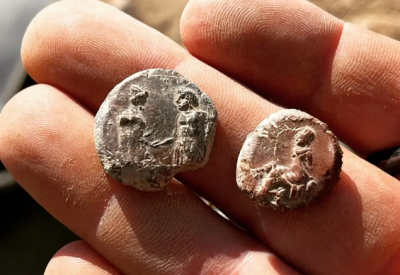
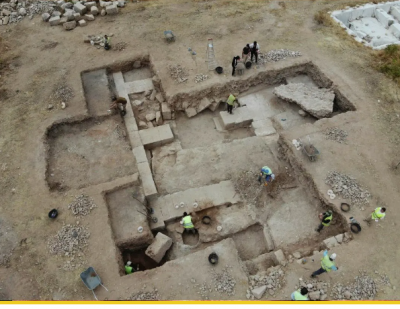 Doliche - Doliche was founded as a Hellenistic colony during the 2nd century BC in the present-day province of Gaziantep, Turkey. During antiquity, the city was located in the ancient region of Cyrrhestica, which was annexed by the Roman Empire in AD 72. A recent study by the Asia Minor Research Centre has found over 2,000 seal impressions used to seal documents from the city municipal archive. The impressions consist of stamped clay lumps that range from 5 millimetres to 2 centimetres in size. According to Professor Michael Blömer from the University of Münster: “The images of the official city seals have a direct urban connection. As a rule, they show their most important deities such as Jupiter Dolichenus, the main god of the city.” Between the mid-second and mid-third century AD, the veneration of Jupiter Dolichenus gained widespread popularity within the Roman military. Several religious structures dedicated to Jupiter Dolichenus identify him as the “deity of the Commagenians.” The smaller private seals exhibit a diverse array of images and symbols, shedding light on the cultural impact that religion played in the lives of the people of Doliche. “The gods on the seals provide insights into people’s religious environment. Mythical figures or rare private portraits indicate a strong Greco-Roman influence,” said Professor Blömer. The well-preserved seal impressions and their motifs also provide information about ancient administrative practices.The seals were found in the lower foundations of an archive building made of solid limestone blocks. The building measures 8 x 25 metres in size and was a multi-story structure containing a sequence of rooms. While each Roman city had archives designated for contract storage, only a few archive structures from the Roman Empire have been identified thus far. According to the researchers: “The archive documents themselves were destroyed in a major fire, possibly in AD 253 when the Persian king, Šāpūr I, destroyed numerous cities in the Roman province of Syria.”
Doliche - Doliche was founded as a Hellenistic colony during the 2nd century BC in the present-day province of Gaziantep, Turkey. During antiquity, the city was located in the ancient region of Cyrrhestica, which was annexed by the Roman Empire in AD 72. A recent study by the Asia Minor Research Centre has found over 2,000 seal impressions used to seal documents from the city municipal archive. The impressions consist of stamped clay lumps that range from 5 millimetres to 2 centimetres in size. According to Professor Michael Blömer from the University of Münster: “The images of the official city seals have a direct urban connection. As a rule, they show their most important deities such as Jupiter Dolichenus, the main god of the city.” Between the mid-second and mid-third century AD, the veneration of Jupiter Dolichenus gained widespread popularity within the Roman military. Several religious structures dedicated to Jupiter Dolichenus identify him as the “deity of the Commagenians.” The smaller private seals exhibit a diverse array of images and symbols, shedding light on the cultural impact that religion played in the lives of the people of Doliche. “The gods on the seals provide insights into people’s religious environment. Mythical figures or rare private portraits indicate a strong Greco-Roman influence,” said Professor Blömer. The well-preserved seal impressions and their motifs also provide information about ancient administrative practices.The seals were found in the lower foundations of an archive building made of solid limestone blocks. The building measures 8 x 25 metres in size and was a multi-story structure containing a sequence of rooms. While each Roman city had archives designated for contract storage, only a few archive structures from the Roman Empire have been identified thus far. According to the researchers: “The archive documents themselves were destroyed in a major fire, possibly in AD 253 when the Persian king, Šāpūr I, destroyed numerous cities in the Roman province of Syria.”
Archaeologists uncover over 2,000 seal impressions in ancient Doliche (heritagedaily.com)
FRANCE –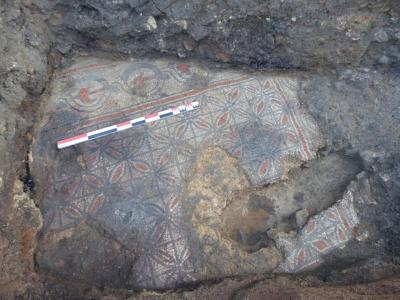 Nevers - Actuellement, les vestiges du baptistère et du portail roman de la cathédrale, conservés sous le sol actuel de l’église, sont accessibles à la visite. À 2,50 m au sud-ouest du baptistère, dans un coude de la tranchée du réseau de chaleur, une mosaïque a été mise au jour. Située à une profondeur de 1,40 m, ce sol se trouve sensiblement à la même altitude que les seuils de pierre permettant l’accès à la cuve baptismale. La mosaïque se compose d’un panneau central constitué de rosaces en tesselles bleues et rouges sur fond blanc. Au sud, le bandeau qui borde le panneau central est conservé dans sa largeur. Il montre un motif de tresse à deux brins associé à un symbole (hache ?) au centre des entrelacs. Au-delà du bandeau latéral sud, la mosaïque laisse place à un sol de tuileau rose. Côté ouest, quelques pierres liées par un mortier sont les rares témoins du mur qui bordait la mosaïque. Ce mur est arasé à quelques centimètres au-dessus de l’altitude du sol de tesselles. Les rares tessons de céramique et les charbons de bois (matière pour les datations au carbone 14) découverts dans l’environnement stratigraphique de la mosaïque permettront peut-être de préciser sa date de construction et d’utilisation. Bien qu’une datation antique de la mosaïque soit possible, sa contemporanéité avec le baptistère construit durant le Ve ou au début du VIe siècle est également envisageable. Une datation plus récente, jusque dans le Moyen Âge central, n’est pas à exclure si l’on considère la mosaïque contemporaine d’une des phases de réfection plus récente du baptistère.
Nevers - Actuellement, les vestiges du baptistère et du portail roman de la cathédrale, conservés sous le sol actuel de l’église, sont accessibles à la visite. À 2,50 m au sud-ouest du baptistère, dans un coude de la tranchée du réseau de chaleur, une mosaïque a été mise au jour. Située à une profondeur de 1,40 m, ce sol se trouve sensiblement à la même altitude que les seuils de pierre permettant l’accès à la cuve baptismale. La mosaïque se compose d’un panneau central constitué de rosaces en tesselles bleues et rouges sur fond blanc. Au sud, le bandeau qui borde le panneau central est conservé dans sa largeur. Il montre un motif de tresse à deux brins associé à un symbole (hache ?) au centre des entrelacs. Au-delà du bandeau latéral sud, la mosaïque laisse place à un sol de tuileau rose. Côté ouest, quelques pierres liées par un mortier sont les rares témoins du mur qui bordait la mosaïque. Ce mur est arasé à quelques centimètres au-dessus de l’altitude du sol de tesselles. Les rares tessons de céramique et les charbons de bois (matière pour les datations au carbone 14) découverts dans l’environnement stratigraphique de la mosaïque permettront peut-être de préciser sa date de construction et d’utilisation. Bien qu’une datation antique de la mosaïque soit possible, sa contemporanéité avec le baptistère construit durant le Ve ou au début du VIe siècle est également envisageable. Une datation plus récente, jusque dans le Moyen Âge central, n’est pas à exclure si l’on considère la mosaïque contemporaine d’une des phases de réfection plus récente du baptistère.
Actualité | Suivis archéologiques dans le centre historique ... | Inrap
ITALIE –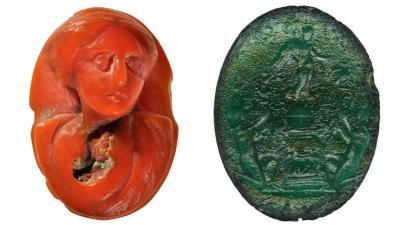
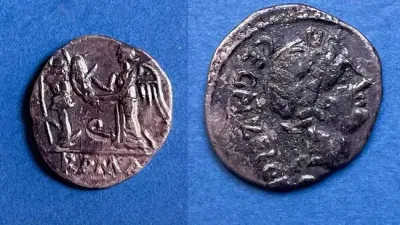 Claterna - Archaeologists have unearthed 50 unique jewels during ongoing excavations at Claterna, the ancient Roman site known as the ‘Pompeii of the North’. Along with the jewels, 3,000 coins were also found. Even more significant is the discovery of 50 engraved gems, suggesting the possible presence in the city of a workshop specialized in their production. The jewel of the discovery, however, is an exceptional ‘quinarius’, dating back to 97 BC. This coin features a detailed depiction of a ‘winged victory’ writing on a shield, resting on a trophy. The clear presence of the writing ‘ROMA’ testifies to the celebration of military victories and the city’s connection with Roman power. Lucia Borgonzoni stated that “the finds yield very precious and significant materials”. The discovery of the silver coins and colored gems, presumably produced locally, suggests that Claterna was not only a transit center, but also a lively commercial center. Archaeologists also unearthed dozens of colored gems engraved with the likenesses of various deities and important structures, including the same theater. Researchers have only excavated about one-tenth, or about 44 acres (18 hectares), of the city thus far; excavations at the site will continue
Claterna - Archaeologists have unearthed 50 unique jewels during ongoing excavations at Claterna, the ancient Roman site known as the ‘Pompeii of the North’. Along with the jewels, 3,000 coins were also found. Even more significant is the discovery of 50 engraved gems, suggesting the possible presence in the city of a workshop specialized in their production. The jewel of the discovery, however, is an exceptional ‘quinarius’, dating back to 97 BC. This coin features a detailed depiction of a ‘winged victory’ writing on a shield, resting on a trophy. The clear presence of the writing ‘ROMA’ testifies to the celebration of military victories and the city’s connection with Roman power. Lucia Borgonzoni stated that “the finds yield very precious and significant materials”. The discovery of the silver coins and colored gems, presumably produced locally, suggests that Claterna was not only a transit center, but also a lively commercial center. Archaeologists also unearthed dozens of colored gems engraved with the likenesses of various deities and important structures, including the same theater. Researchers have only excavated about one-tenth, or about 44 acres (18 hectares), of the city thus far; excavations at the site will continue
Unique Gems found in Claterna, known as the 'Pompeii of the North' - Arkeonews
ECOSSE – 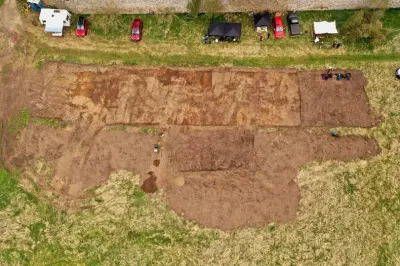
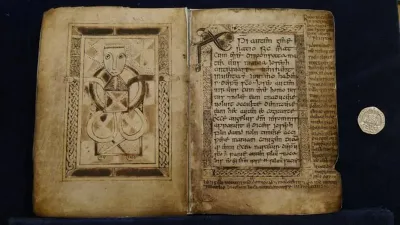 Buchan - Archaeologists have discovered the site of a 10th century monastery linked to the first written record of the Scottish Gaelic language. The monastery in Aberdeenshire is thought to be where the ancient Book of Deer was first scribed. Monks in Aberdeenshire added Gaelic notes to the manuscript as late as the 12th century, which became the earliest surviving written record of the language. The site of the “missing” monastery was found under a field next to Deer Abbey in Buchan, which dates to the 13th century. Gaelic-speaking archaeology graduate Mairead Morgan said: “At the beginning of the 12th century, the earliest evidence of Scottish Gaelic was written in the margins of this Latin gospel book by the monks in a monastery in Aberdeenshire, a region which is not widely regarded as a Gaelic-speaking region today. “However, not only does this show that Gaelic was spoken in the region, but it is also the earliest evidence that exists of written Scottish Gaelic by a good 200 to 300 years, which easily makes the Book of Deer one of the most important manuscripts in Scotland.”
Buchan - Archaeologists have discovered the site of a 10th century monastery linked to the first written record of the Scottish Gaelic language. The monastery in Aberdeenshire is thought to be where the ancient Book of Deer was first scribed. Monks in Aberdeenshire added Gaelic notes to the manuscript as late as the 12th century, which became the earliest surviving written record of the language. The site of the “missing” monastery was found under a field next to Deer Abbey in Buchan, which dates to the 13th century. Gaelic-speaking archaeology graduate Mairead Morgan said: “At the beginning of the 12th century, the earliest evidence of Scottish Gaelic was written in the margins of this Latin gospel book by the monks in a monastery in Aberdeenshire, a region which is not widely regarded as a Gaelic-speaking region today. “However, not only does this show that Gaelic was spoken in the region, but it is also the earliest evidence that exists of written Scottish Gaelic by a good 200 to 300 years, which easily makes the Book of Deer one of the most important manuscripts in Scotland.”
CHINE – 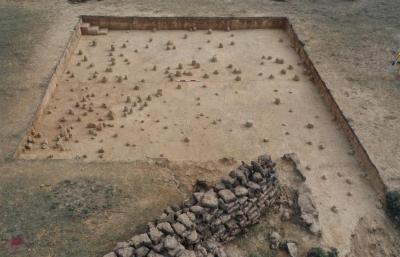 Sichuan - More than 200 Paleolithic sites have been found in southwest China's Sichuan Province since 2019, challenging the claim that the area had scarce hominins in the Old Stone Age. The 200 sites, where many stone tools and human remains have been unearthed, are scattered across the Sichuan basin and the western Sichuan plateau. They include the Mengxihe Site in Ziyang City, the Taohuahe site in Suining City, and the Wangjiayan site in the provincial capital, Chengdu. The findings suggest that as early as the Paleolithic Age, Sichuan was already a significant area for cultural exchange and population migration between the East and the West and between China's northern and southern regions, said Zheng.
Sichuan - More than 200 Paleolithic sites have been found in southwest China's Sichuan Province since 2019, challenging the claim that the area had scarce hominins in the Old Stone Age. The 200 sites, where many stone tools and human remains have been unearthed, are scattered across the Sichuan basin and the western Sichuan plateau. They include the Mengxihe Site in Ziyang City, the Taohuahe site in Suining City, and the Wangjiayan site in the provincial capital, Chengdu. The findings suggest that as early as the Paleolithic Age, Sichuan was already a significant area for cultural exchange and population migration between the East and the West and between China's northern and southern regions, said Zheng.
Over 200 Paleolithic sites found in China's Sichuan - SHINE News
GRECE – 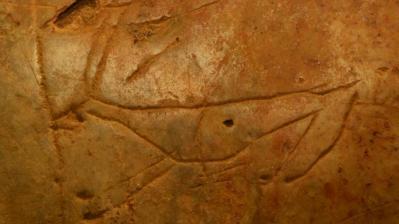 Asphendou - The earliest Greek cave art depicting extinct animals was discovered on Crete and is believed to be at least 11,000 years old. Dating back to the last Ice Age, the artwork was found in Asphendou Cave located near the village of Asphendou in the province of Sfakia. The cave is a very small rock shelter without much depth that barely fits two people and is located on a hillside at the beginning of the canyon Asphendou. A visit to the cave requires meeting the man at the village who holds the key to the door since the cave is locked. The confusion was caused because several layers of engraving were superimposed on one another. Initially, it was believed that the animal depictions were feral goats and possibly as late as the Bronze Age. However, archaeologists exposed the oldest layers, now showing a species of recently identified fossil dwarf deer named Candiacervus ropalophorus, which became extinct more than 11,000 years ago.The species has unusually long antlers with short lateral tines, and specimens found not far north of Asphendou in caves on the north coast of Crete date to between 21,500 and 11,000 years ago. The 37 deer engravings identified at Asphendou are tiny — about 5cm long — and the engravings shallow. They represent “a Paleolithic animal herd without ground line or background”. Another Paleolithic artistic convention includes showing both antlers as though in three-quarter view, while the body is in profile, Strasser’s team report in the Journal of Archaeological Science.“The last occurrence of the Cretan dwarf deer Candiacervus confirms the Asphendou rock carvings as the oldest figural art found in Greece,” they wrote. “Paleolithic artists represented what they knew, in this case a prevalent species which became extinct in the upper Paleolithic”.
Asphendou - The earliest Greek cave art depicting extinct animals was discovered on Crete and is believed to be at least 11,000 years old. Dating back to the last Ice Age, the artwork was found in Asphendou Cave located near the village of Asphendou in the province of Sfakia. The cave is a very small rock shelter without much depth that barely fits two people and is located on a hillside at the beginning of the canyon Asphendou. A visit to the cave requires meeting the man at the village who holds the key to the door since the cave is locked. The confusion was caused because several layers of engraving were superimposed on one another. Initially, it was believed that the animal depictions were feral goats and possibly as late as the Bronze Age. However, archaeologists exposed the oldest layers, now showing a species of recently identified fossil dwarf deer named Candiacervus ropalophorus, which became extinct more than 11,000 years ago.The species has unusually long antlers with short lateral tines, and specimens found not far north of Asphendou in caves on the north coast of Crete date to between 21,500 and 11,000 years ago. The 37 deer engravings identified at Asphendou are tiny — about 5cm long — and the engravings shallow. They represent “a Paleolithic animal herd without ground line or background”. Another Paleolithic artistic convention includes showing both antlers as though in three-quarter view, while the body is in profile, Strasser’s team report in the Journal of Archaeological Science.“The last occurrence of the Cretan dwarf deer Candiacervus confirms the Asphendou rock carvings as the oldest figural art found in Greece,” they wrote. “Paleolithic artists represented what they knew, in this case a prevalent species which became extinct in the upper Paleolithic”.
11,000-Year-Old Greek Cave Art Found on Crete (greekreporter.com)
IRAQ – 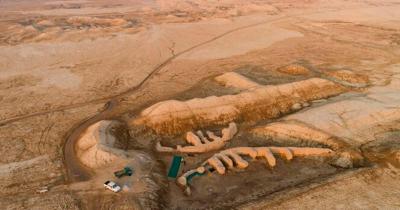 Girsu - A recent dig at Girsu revealed “a mysterious structure,” which in the 1920s was interpreted as an unusually shaped temple. However, members of the museum’s Girsu Project have discovered the true function of a mysterious structure created by the civilization. The team describe the ancient lifesaving device as a “flume” that was used to deliver water to distant locations for agriculture. A way of life threatened by vital canals drying up seems to have led the Sumerians, who were the first to tell early versions of the biblical story of the flood, to create this “anti-drought machine.” Ebru Torun, an architect and conservationist working with the British Museum team in Iraq, said: “This is absolutely one of a kind. There is no other example of it in history, really, until the present day.” In a Telegraph article, Dr. Sébastien Rey, an archaeologist and the project’s leader in Iraq, explained that the people “saw the canals drying up, silting up, one by one.” He added that “It is not just a bridge, it’s an anti-drought machine, anti-collapse.” Furthermore, all of the inscribed stone tablets speak of “a water crisis, and one last desperate attempt to save themselves,” added Rey. Their civilization revolved around water and relied on advanced irrigation, which directed water from the Tigris and Euphrates rivers into canals that watered fields, providing the food required to sustain urban life. It was part of an order maintained by gods, who in turn were maintained by sacrifice and libations, but when the gods abandoned Girsu, the Sumerians were forced to effect their own salvation.
Girsu - A recent dig at Girsu revealed “a mysterious structure,” which in the 1920s was interpreted as an unusually shaped temple. However, members of the museum’s Girsu Project have discovered the true function of a mysterious structure created by the civilization. The team describe the ancient lifesaving device as a “flume” that was used to deliver water to distant locations for agriculture. A way of life threatened by vital canals drying up seems to have led the Sumerians, who were the first to tell early versions of the biblical story of the flood, to create this “anti-drought machine.” Ebru Torun, an architect and conservationist working with the British Museum team in Iraq, said: “This is absolutely one of a kind. There is no other example of it in history, really, until the present day.” In a Telegraph article, Dr. Sébastien Rey, an archaeologist and the project’s leader in Iraq, explained that the people “saw the canals drying up, silting up, one by one.” He added that “It is not just a bridge, it’s an anti-drought machine, anti-collapse.” Furthermore, all of the inscribed stone tablets speak of “a water crisis, and one last desperate attempt to save themselves,” added Rey. Their civilization revolved around water and relied on advanced irrigation, which directed water from the Tigris and Euphrates rivers into canals that watered fields, providing the food required to sustain urban life. It was part of an order maintained by gods, who in turn were maintained by sacrifice and libations, but when the gods abandoned Girsu, the Sumerians were forced to effect their own salvation.
